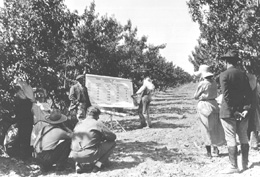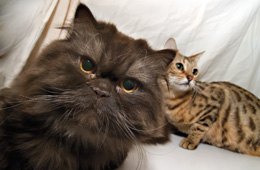Volume 25 · Number 3 · Spring 2008
News & Notes

In memoriam
Is your soap hurting your health?
A new UC Davis study shows that a common antibacterial chemical added to bath soaps can alter hormonal activity in rats and in human cells in the laboratory.
The findings come as an increasing number of studies — of both lab animals and humans — are revealing that some synthetic chemicals in household products can cause health problems by interfering with normal hormone action.
Called endocrine disruptors, such chemicals have been linked in animal studies to a variety of problems, including cancer, reproductive failure and developmental anomalies.
This is the first endocrine study to investigate the hormone effects of the antibacterial compound triclocarban (also known as TCC or 3,4,4'-trichlorocarbanilide), which is widely used in household and personal care products, including bar soaps, body washes, cleansing lotions, wipes and detergents. Triclocarban-containing products have been marketed broadly in the United States and Europe for more than 45 years; an estimated 1 million pounds of triclocarban are imported annually for the U.S. market.
The researchers found two key effects: In human cells in the laboratory, triclocarban increased gene expression that is normally regulated by testosterone. And when male rats were fed triclocarban, testosterone-dependent organs such as the prostate gland grew abnormally large.
The discovery that triclocarban increased hormone effects was new. All previous studies of endocrine disruptors had found that they generally act by blocking or decreasing hormone effects.
“This finding may eventually lead to an explanation for some rises in some previously described reproductive problems that have been difficult to understand,” said one author, Bill Lasley, a UC Davis expert on reproductive toxicology and professor emeritus of veterinary medicine. More analyses of antibacterials and endocrine effects are planned, he said.
Consumers should not take this study as guidance on whether to use triclocarban-containing products, Lasley said, though he added, “Our mothers taught us to wash our hands well before the advent of antimicrobial soaps, and that practice alone prevents the spread of disease.”
— Sylvia Wright
Stepping up grant oversight
UC Davis has tightened financial controls after internal reviews of accounting and management practices in a Food Stamp Nutrition Education Program concluded that university personnel misused federal grant funds and committed fraud. The findings, announced this winter, also prompted the university to initiate outside reviews and commit to repay funds.
Three separate internal audits identified fraud and found failures in internal financial controls and management oversight of the program, which educates thousands of food stamp recipients throughout California on proper diet and nutritious food purchases. Campus officials believe that the program, which had a total budget of nearly $12.9 million in 2006–07, has continued to provide a high level of service to participants.
UC Davis reported the accounting and management lapses to the California Department of Social Services, which administers the program funding on behalf of the U.S. Department of Agriculture. UC Davis expects to repay the state approximately $600,000 for fraudulent or inappropriate expenditures identified by its audits. The campus is working with the state to determine if any additional repayment is required.
In addition, UC Davis officials have transferred oversight of the Food Stamp Nutrition Education Program from the university’s Department of Nutrition to the dean’s office of the College of Agricultural and Environmental Sciences.
UC Davis also has been cooperating with the United States Attorney’s Office in Sacramento and the USDA Office of Inspector General, as they conduct a joint criminal investigation into the program and its activities. The fraud and mismanagement allegations were initially reported to UC Davis officials in August 2006 as a whistleblower complaint.
“From the moment my office learned of possible problems, we conducted extensive internal reviews and turned over our findings to the relevant government agencies,” said UC Davis Chancellor Larry Vanderhoef. “We take our responsibilities in administering this program very seriously. We are following every possible avenue to repay funds and to make certain that our policies and processes are followed correctly.”
— Lisa Lapin
Education from the outside in
As the campus nears its 2008–09 centennial celebration, we take a look back at what was happening 100 years ago.

A dormitory had yet to be built, and one of the first faculty members, dairy instructor Emil Hagemann, became gravely ill with appendicitis just months after he moved to the new Davis campus.
But, with two instructional buildings constructed and research getting under way, University of California officials began in spring 1908 to recruit the first students for the inaugural courses at the University Farm.
The “farmers’ short courses” to be offered the following fall were not new. The university had held them at Berkeley and other places around the state for a number of years. But the opening of the Davis site had been widely anticipated, providing what UC touted as its first “field operations” for practical instruction in agriculture on par with “eastern institutions of longer standing.”
As Edward Wickson, dean of the UC College of Agriculture and director of the Agricultural Experiment Station, said in an article in the Pacific Rural Press newspaper: “We expect to realize for the University of California the greatest institution for agricultural research and instruction in the world.”
The short courses were open to anyone — male or female — who was at least 17 years old. As a UC brochure at the time declared: “Everybody may come.” Southern Pacific Railroad offered discount round-trip fares from other California towns to Davis.
Five courses were offered: “Dairy Manufacture,” “Irrigation, Soils, Forage Crops and Cereals,” “Poultry Husbandry,” “Animal Industry and Veterinary Science” and “Horticulture and Viticulture.” They ranged from eight days to eight weeks long, and the fee for the longest was $10. A single-page application asked about the applicant’s previous farm or creamery experience.
A total of 109 people, including at least a dozen women, would attend that October and November. And by then, Hagemann had recovered from his appendectomy and helped teach the dairying lessons.
Regular courses would begin in January 1909, launching what then-UC President Benjamin Wheeler called “a new and significant departure for the education of California youth.”
Although tuition was free, the regular courses were not initially open to all youth, just young men who had finished eighth grade. The university planned from the start to admit girls once a separate dormitory, the future South Hall, was constructed. The first women to enroll in the regular courses would arrive in 1914.
The opening of the University Farm, Wheeler said in a fall 1907 dedication speech, was part of a nationwide movement, led by agricultural educators and students, to teach “real things” and to “reverse the direction of the prevailing book- and blackboard-education and move from the outside in, instead of from the inside out.”
— Kathleen Holder
Tracing the cat family tree

Despite its name, the Persian cat is more closely related to European cats than those from the Near East, a genetic study found. However, researchers found that all domestic cats share common roots in the Mediterranean. (Karin Higgins/UC Davis photo)
The Fertile Crescent of the Middle East has long been identified as a “cradle of civilization” for humans. In a new genetic study, UC Davis researchers have concluded that all ancestral roads for the modern-day domestic cat also lead back to the same locale.
For the study, the scientists collected samples of cheek cells from more than 11,000 cats. These cats represented 17 populations of randomly bred cats from Europe, the Mediterranean, Asia, Africa and the Americas, as well as 22 recognized breeds.
“This study confirms earlier research suggesting that the domestication of the cat started in the Fertile Crescent region,” said Monika Lipinski, lead researcher on the study and a doctoral candidate in the School of Veterinary Medicine. “It also provides a warning for modern cat fanciers to make sure they maintain a broad genetic base as they further develop their breeds.”
Earlier archaeological evidence and research on the evolutionary history of cats have suggested that cat domestication began about 5,000 to 8,000 years ago in the Fertile Crescent — an area stretching from Turkey to northern Africa and eastward to modern day Iraq and Iran. Cat domestication occurred as humans transitioned from nomadic herding to raising crops and livestock.
Cats, with their penchant for hunting mice, rats and other rodents, became useful companions as people domesticated, grew and stored wild grains and grasses. Eventually, cats also became pets but were never fully domesticated. Even today, most domestic cats remain self-sufficient, if necessary, and continue to be efficient hunters, even when provided with food.
Cats and their gene pools spread rapidly around the world as ancient civilizations developed trade routes. Unlike other domesticated species, there has been little effort to improve on the cat for functional purposes. Instead, development of cat breeds has been driven more by preferences for certain aesthetic qualities like coat color and color patterns.
Today, there are 50 recognized cat breeds. Of that total, 16 breeds are thought to be “natural breeds” that occurred in specific regions, while the remaining breeds were developed during the past 50 years.
From the DNA analysis, the researchers found that the cats were genetically clustered in four groups that corresponded with the regions of Europe, the Mediterranean basin, east Africa and Asia.
They discovered that randomly bred cats in the Americas were genetically similar to randomly bred cats from Western Europe. They also found that the Maine coon and American shorthair — two breeds that originated in the United States — were genetically similar to the seven Western European breeds. This suggests that cats brought to the New World by European settlers have not had sufficient time to develop significant genetic differentiation from their Western European ancestors.
In addition, the researchers determined that the Persian breed, perhaps the oldest recognized pure breed, was not genetically associated with randomly bred cat populations from the Near East, but rather was more closely associated with randomly bred cats of Western Europe.
Among Asian breeds, only the Japanese bobtail was genetically clustered with Western cats, although it did retain some Asian influence.
Cats from the Mediterranean region were found to be genetically uniform, perhaps a result of the constant movement of ships and caravans during the early era of the cat’s domestication, the researchers suggested.
The study found that genetic diversity remained surprisingly broad among cats from various parts of the world. However, the data indicated that there was some loss of diversity associated even with the long-term development of foundation cat breeds, which provided the genetic basis from which modern pure breeds were developed.
“More than 200 genetic disorders have been identified in modern cats, and many are found in pure breeds,” said Leslie Lyons, an authority on cat genetics who oversaw this study. “We hope that cat breeders will use the genetic information uncovered by this study to develop efficient breed-management plans and avoid introducing genetically linked health problems into their breeds.”
For more information about cat genomics research in the Lyons lab, visit http://faculty.vetmed.ucdavis.edu/faculty/lalyons/Sites/LyonsDenHomepage.htm.
— Pat Bailey
